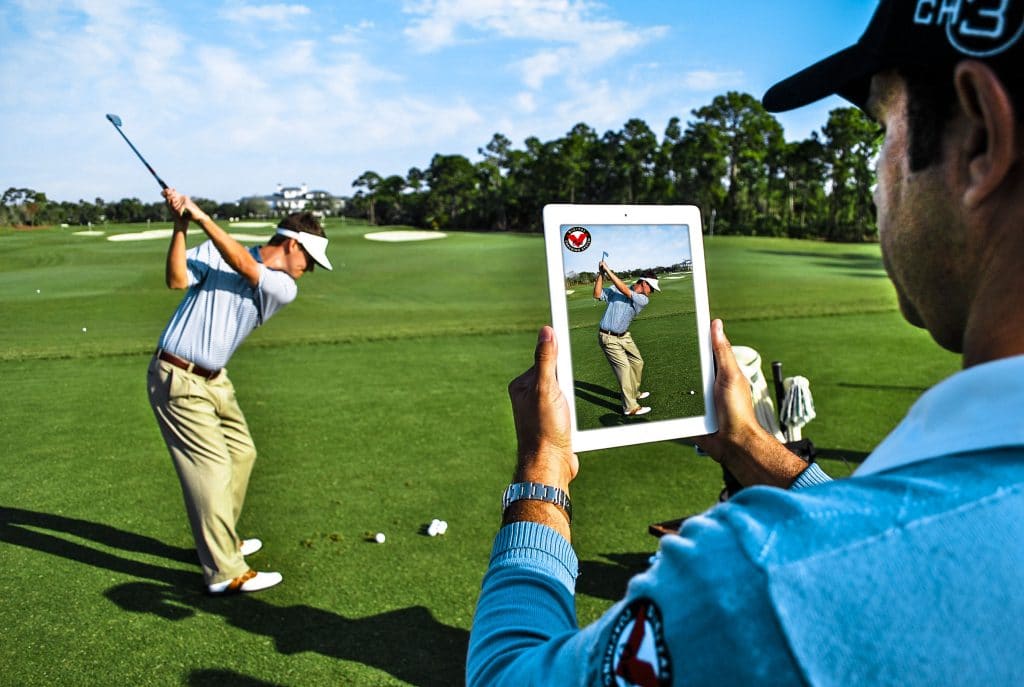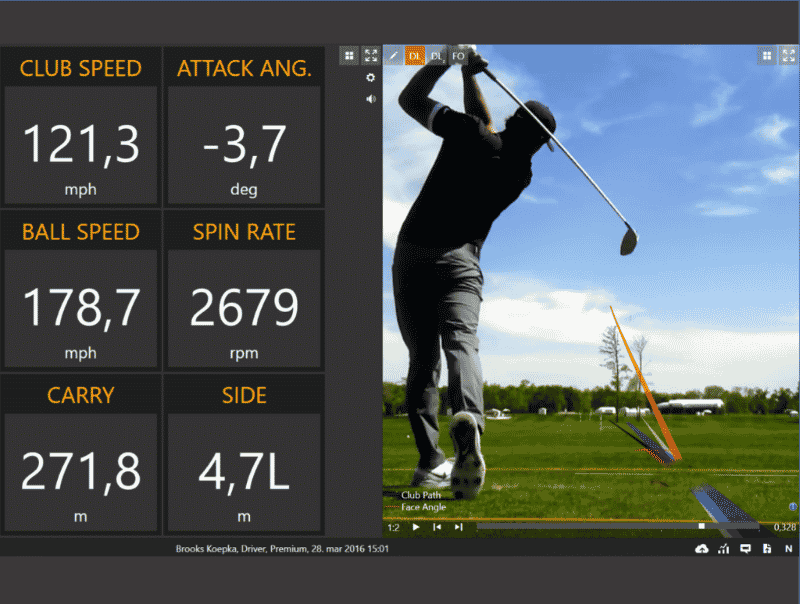The topic of golf lessons is one that continually divides opinion – and will probably keep doing so from now until the end of time.
Some players swear by them, arguing you are little to no chance of reaching a single-digit handicap without getting lessons, while others are happier trying to figure out their swing on their own.
Lucky for you, I’ve done both – so I have a bit of experience when answering the all-important question: Are golf lessons worth it?
Golf lessons are absolutely worth it. You won’t become a scratch golfer overnight, but in 10 weeks I shaved six strokes off my handicap by getting regular lessons with a good PGA professional. Lessons are essential for beginners who are trying to learn the basics, and can lay a solid foundation for a good golf swing.
But the key thing is finding yourself a good pro to learn from. If you don’t, you’re wasting your time.
You see, I took up the game of golf around three years ago and tried a number of different instructors within the first 12 months without seeing any real improvement.
They didn’t communicate their drills and swing fixes very well to me during each lesson, which meant I found it difficult to practice what they were preaching.
After visiting my third pro, and with my handicap not budging from around 22, I gave up on lessons – and spent the best part of the next two years trying to teach myself by watching YouTube videos, reading swing tips online and recording my own swing.
I managed to get myself down to a handicap of 20.1, but almost three months ago – having joined a new golf club as a member and getting frustrated at my handicap not budging – I decided to give my new club’s pro a try.
And I’m so glad I did, because after just seven lessons I had reached a personal best handicap of 14.1 and shot my lowest-ever score of 79 (and that even included a few three putts!).
With the right teacher guiding me, I finally feel like I’m edging closer and closer to my goal of becoming a single-figure golfer.
I’ve written another article about what you should look for in a golf instructor here, and I definitely recommend you give it a read before heading along to your first golf lesson (if you decide to give one a try).
In this article, I’ll answer some of the key questions regarding golf lessons, including:
- When you should take golf lessons
- How you should prepare for golf lessons
- How much golf lessons cost
- Can you improve without golf lessons
So, if you’re keen to learn everything you need to know about golf lessons, read on!
Table of contents
Is golf difficult to learn?
Golf is an extremely difficult game to learn, because there are so many variables you need to consider when making a swing – and it all happens in just one second. Factors such as angle of attack, clubface direction – either open or closed at impact – swing direction, wrist angles, swing plane can all work with or against you to send your ball at your target, or careening offline.
When you consider the PGA Tour average time for the backswing is 0.75 seconds, and the downswing just 0.25 seconds, it’s almost impossible to consciously fix a fault mid-swing.
In the United States the average male handicap for players is 16.1 while in Australia the average male handicap is 18.1. For females, that increases to 28.9 and 27.5 respectively.
So, while you may have the lofty ambition of becoming a scratch golfer, the unfortunate reality is to get there requires thousands of hours of deliberate practice – ideally guided by a golf instructor – and, as you can see by the average handicap numbers, the majority of players never get there.
That’s not to say, however, you can’t get down to single figures with some dedication.
I work a full-time, 38-hour a week job but still find time to play once a week, and head to the driving range before or after work around twice a week which has helped improved my game dramatically.
If you want it bad enough, you’ll find time to practice. It’s the only way to get better.
When should I take golf lessons?
You should take lessons as early as possible in your golfing journey, so long as you can afford it. Learning the correct movements and technique from a qualified PGA professional before any bad habits become ingrained will help you progress and improve much faster.
Don’t be like me and waste two-and-a-half years trying to figure out your swing on your own – while you may make gradual improvements, you’ll more likely just keeping going around and around in circles without seeing your handicap budge much at all.
Had I found the right instructor three years ago when I first started playing golf seriously – and actually continued getting lessons – I may have already reached my goal of being a single-figure player.
While I’m making up for lost time now, I could have been much further along with my progression than what I am had I got lessons as soon as I first picked up a club.
So, if you’re serious about improving, get a golf lesson as soon as you possibly can – you’ll be glad you did.
How do you prepare for a golf lesson?
If you’ve never had a golf lesson before, it may seem like a daunting occasion – but don’t worry, they’re anything but.
Below is a list of things you’ll need to take with you to your lesson:
- Golf clubs
- Golf attire (ideally, you’d arrive dressed as if you were playing in a competition)
- Water
- Sunglasses (in case it’s a bright day)
- Sunscreen (especially if you’re hitting on an outdoor range)
It’s advisable to arrive around 30 minutes early to your lesson, as your instructor will usually give you a bucket of range balls to hit in order to warm up sufficiently.
Stretch before swinging
But before you take any full swings, it’s important to warm up first.
You may think you’ll look like a bit of a goose doing some stretches on the range, but trust me – not only will it may you swing more freely, it will also reduce your risk of injury.
Below is a great video showing some simple exercises you can do to loosen up before your lesson.
You don’t have to do all of them, but incorporating at least a few of these stretches before making your first swing will ensure you’re ready to play your best golf.
WATCH THE FULL STRETCHING VIDEO BELOW:
Range warm-up routine
So, once you’ve completed some stretches, it’s time to hit that bucket of balls in preparation of your golf lesson.
Unless your pro has specifically said you’ll be working on putting or chipping for your first lesson, it’s safe to assume you’ll be focusing most of your time on your full swing – and as such, you should warm up accordingly.
A small-to-medium range bucket typically has around 35-45 balls in it, which is an ideal amount to start with.
Below is the practice routine of the world’s greatest-ever golfer, Tiger Woods, in regards to his long game. And it’s perfect for you to copy while on the range.
Before a round, Tiger makes 44 full swings during his warm-up. This is how many times he hits each club, in this order:
- 17 sand wedges
- 13 eight irons
- 10 four irons
- 4 five woods
- 4 three woods
- 5 drivers
- 6 pitching wedges
- 2 more drivers
- 7 more sand wedges
You can adapt this routine as you see fit – especially as you may not have all these clubs in your bag – but if it’s good enough for a 15-time major winner, then it will be a great foundation for you with your range session.
Having done all this preparation, you should be ready to start your golf lesson.
WATCH TIGER’S FULL WARM-UP ROUTINE BELOW:
How many golf lessons should a beginner take?
I would recommend starting with a block of at least five golf lessons to begin with if you are new to the game. This will give your instructor enough time to diagnose your swing faults and advise you on how to fix them, and also give you adequate time to implement and practice those changes in your spare time.
Usually, booking in a block of lessons will come at a discounted rate too, which can help you save money.
I would suggest taking lessons weekly to begin with, as you’ll likely forget some of the instructions you’ve been given and need regular guidance and reinforcement to permanently groove your swing changes.
Once you have a firmer grasp on what you need to do, you can then look at taking lessons fortnightly or even monthly, depending on how fast you progress.
Talk to your pro and they will be able to guide you on this.
At the end of the day, the regularity of your lessons will come down to your budget, how quickly you wish to improve, and the speed at which you’re getting results.
Will golf lessons improve my game?
Yes – but only if you are taught by a good golf instructor, and only if you are dedicated to your practice. A good teacher will point you in the right direction, and give you the appropriate drills to work on, but how much you improve depends on how committed you are to practicing.
As I wrote in another article, if you get stuck with a teacher who doesn’t use the latest swing analysis technology such as Trackman or FlightScope, or who talks for most of the lesson rather than helping you get better, your progress will undoubtedly be much slower.
I’d highly recommend you read that article before settling on a golf instructor long-term – it could save you a lot of time and money.
Similarly, a good golf instructor can only take you so far.
They can give you all the tools and guidance you need to succeed, but ultimately it falls on you to practice what you’ve learnt.
We wrote another in-depth article about how much you should practice here – this will explain the dedication needed to improve your game.

Can golf lessons make you worse?
Sadly, yes – especially if you get given bad advice from your golf instructor during your first lesson. If your teacher is using outdated methods or misdiagnoses your swing from the start, it’s possible you could get worse, rather than better.
As I mentioned in the intro to this article, a couple of pros I saw early on in my golfing journey just didn’t click with me – they tried a few one-size-fits-all drills to try and help me get better, when in reality all it did was make me worse.
My handicap didn’t budge, and I was hitting the ball horrendously.
And trust me, when this happens you can get very discouraged and disillusioned with the game.
You start to think that lessons are a waste of time and money, when in reality they are the only way you will ever truly get better.
It wasn’t until I landed on my current instructor that my game really improved because he understood my swing, and tried a variety of different drills before finding one that I could understand and implement.
I can’t stress this enough – don’t stay with one instructor if after five lessons you have seen zero results.
Don’t be afraid to shop around and find a pro who truly understands your swing, and gets quick results.
Can you get good at golf without lessons?
Unless you’re two-time Masters winner Bubba Watson – who claims to have never had a golf lesson in his life – the answer is most likely no. Golf lessons are a great way to build the foundations of a solid golf swing under the guidance of a qualified pro, which is far better than going it alone.
At least, that has been my experience. I spent the best part of two years trying to figure out the game on my own, and my handicap barely budged in that time.
It wasn’t until I started getting lessons with a great instructor that I really started seeing consistent improvement.
It also depends on what you define as ‘good’.
Someone who plays off 18 will be seen as a very good golfer in the eyes of a 36 handicapper.
But if by ‘good’ you mean single figures or lower, then it’s unlikely you’ll reach such a level without golf lessons, and the guidance of a professional golf instructor.
What do golf lessons cost?
The cost of golf lessons will largely depend on the qualifications of the golf instructor. The standard going rate for most PGA professionals is $50-$60 AUD for a 30-minute lesson, and $100-120 AUD for a 60-minute lesson.
But if you want to get a lesson with a high-profile swing coach, such as George Gankas (who coaches PGA winner Matt Wolff), or even YouTube pros Mark Crossfield or Rick Shiels, you could expect to pay a much higher hourly rate.

Can I teach myself golf?
The only people qualified to teach themselves golf are PGA professionals who have gone through the proper training to understand how the golf swing works, and how to fix swing faults when they arise. Sure, you can attempt to teach yourself golf, but as an amateur you may actually make your swing worse rather than better.
For someone like you and me, whose only expertise on the golf swing comes from what we read online or watch on YouTube, trying to teach ourselves golf in most instances is a recipe for disaster.
If you truly want to get better, find a good golf instructor and book in a lesson.
Having tried both teaching myself and getting professional tutelage, I can safely say lessons are the only way to go.
- TaylorMade SIM2 Max Driver vs M4 Driver: Worth it in 2024? - April 15, 2024
- 3 Ways to Win the Mental Game with the Bridgestone Mindset Golf Ball - March 29, 2024
- TaylorMade SIM Max & SIM2 Max Drivers: Are they Still Relevant in 2024? - March 9, 2024



